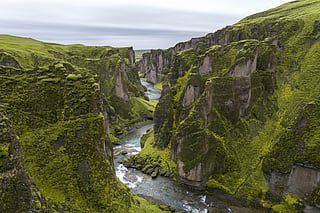- Destinations
- Experiences
- Stay
- What's new
- Editor’s Picks
- Responsible Tourism
- CampaignsCampaigns
- Subscribe

To the east of Greenland, situated in the North Atlantic Ocean, lies the diminutive island nation of Iceland, near the Arctic Circle. Approximately 11 per cent of Iceland's territory is blanketed in glacial ice and encircled by water. While this place abounds in breathtaking natural wonders, it was not always a prominent tourist destination.
Nevertheless, over time, the country has been steadily gaining popularity among tourists, with the optimal period for a visit falling between September and March. Yet, like any travel destination worldwide, there are essential considerations to remember before embarking on your Icelandic adventure. Here are 10 things to know before exploring the "land of fire and ice."
Ensure you have precise maps, appropriate gear, and, as you've likely heard, a dose of common sense. Consult a specialized packing list for cold weather or hiking. Contemplate whether your attire would keep you warm and dry when access to a vehicle or shelter is unavailable. Avoid attempting glacier climbing without adequate training, fording rivers in subcompact cars, hiking in jeans, or camping without highly waterproof tents. Once you've covered these essentials, you can fully relax and savour the experience without unnecessary worry.
Prioritise thorough planning before embarking on your journey. Assess travel times, road conditions, weather forecasts, safety precautions, and, especially if you're hiking, the state of trails and any specific requirements (with guidance from the Icelandic Road Administration). Seek insights from locals who can provide valuable information about the distinctive challenges and potential pitfalls in each area, and be sure to take their advice into account. Then, carefully craft a realistic itinerary that suits your needs and expectations.
Despite the hazards inherent in Iceland's rugged terrain, you'll likely notice the absence of ropes or safety rails along cliff faces. Icelanders opt to preserve their pristine natural landscapes, refraining from adding conspicuous barriers or signage; instead, they trust visitors' judgment. It is imperative to be attentive and heed any signs or barriers already in place to ensure your safety and respect the country's commitment to its natural beauty.
Refrain from off-road driving at all costs. This practice is both illegal and harmful to the environment. When tourists disregard the law and venture off designated paths, they leave damaging trails, setting a regrettable example for others. Even if you have a 4WD vehicle, it's essential to adhere to designated roads and routes to preserve Iceland's delicate ecosystem and maintain the integrity of its landscapes.
Visiting the local hotpot to relax and engage in conversations is almost a national pastime in Iceland. However, before you slip into your swimsuit and immerse yourself in the hot springs and pools, it is crucial to thoroughly wash with soap. Since most of these pools are not chemically treated maintaining cleanliness is a paramount consideration to ensure the health and comfort of all visitors.
Iceland's tour companies have experienced and knowledgeable teams that can escort you into remote regions using vehicles, such as super-jeeps, amphibious buses, snowmobiles, helicopters, and more. Opting for a guided tour offers invaluable information and guidance when navigating treacherous terrains that would be unwise to explore independently.
Always bear in mind the essential principles of responsible travel: avoid littering, reduce your environmental footprint, strive to leave places in better condition than you found them, and actively protect the welfare of wildlife and the environment.
The tap water in Iceland is exceptionally pure. Requesting bottled water here can be quite surprising to locals, as the tap water is of such high quality.
In Iceland, a practice similar to many parts of the world is observed where people remove their shoes when entering indoors. It's a good idea to carry a pair of flip-flops or indoor shoes to wear while inside.
Iceland has shifted its economic reliance towards tourism, surpassing its traditional fishing and aluminium industries, which may alter its image as the land of ice and fire. Nevertheless, the surge in tourism presents considerable challenges. The transportation system in the capital is strained, hotels are consistently at capacity, and the proliferation of Airbnb has elevated housing costs, making it difficult for city residents to find affordable homes.
